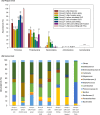Assessment of Chicken Carcass Microbiome Responses During Processing in the Presence of Commercial Antimicrobials Using a Next Generation Sequencing Approach
- PMID: 28230180
- PMCID: PMC5322484
- DOI: 10.1038/srep43354
Assessment of Chicken Carcass Microbiome Responses During Processing in the Presence of Commercial Antimicrobials Using a Next Generation Sequencing Approach
Abstract
The purpose of this study was to 1) identify microbial compositional changes on chicken carcasses during processing, 2) determine the antimicrobial efficacy of peracetic acid (PAA) and Amplon (blend of sulfuric acid and sodium sulfate) at a poultry processing pilot plant scale, and 3) compare microbial communities between chicken carcass rinsates and recovered bacteria from media. Birds were collected from each processing step and rinsates were applied to estimate aerobic plate count (APC) and Campylobacter as well as Salmonella prevalence. Microbiome sequencing was utilized to identify microbial population changes over processing and antimicrobial treatments. Only the PAA treatment exhibited significant reduction of APC at the post chilling step while both Amplon and PAA yielded detectable Campylobacter reductions at all steps. Based on microbiome sequencing, Firmicutes were the predominant bacterial group at the phyla level with over 50% frequency in all steps while the relative abundance of Proteobacteria decreased as processing progressed. Overall microbiota between rinsate and APC plate microbial populations revealed generally similar patterns at the phyla level but they were different at the genus level. Both antimicrobials appeared to be effective on reducing problematic bacteria and microbiome can be utilized to identify optimal indicator microorganisms for enhancing product quality.
Conflict of interest statement
The authors declare no competing financial interests.
Figures










Similar articles
-
Efficacy of neutralizing buffered peptone water for recovery of Salmonella, Campylobacter, and Enterobacteriaceae from broiler carcasses at various points along a commercial immersion chilling process with peroxyacetic acid.Poult Sci. 2019 Jan 1;98(1):393-397. doi: 10.3382/ps/pey361. Poult Sci. 2019. PMID: 30125007
-
Peroxyacetic acid and acidified sodium chlorite reduce microbial contamination on whole chicken carcasses obtained from two processing points.Food Microbiol. 2022 Sep;106:104035. doi: 10.1016/j.fm.2022.104035. Epub 2022 Apr 4. Food Microbiol. 2022. PMID: 35690439
-
Efficacy of various antimicrobials on reduction of salmonella and campylobacter and quality attributes of ground chicken obtained from poultry parts treated in a postchill decontamination tank.J Food Prot. 2014 Nov;77(11):1882-8. doi: 10.4315/0362-028X.JFP-14-114. J Food Prot. 2014. PMID: 25364921
-
Peracetic acid application as an antimicrobial and its residual (HEDP): a holistic approach on the technological characteristics of chicken meat.Poult Sci. 2023 Oct;102(10):103003. doi: 10.1016/j.psj.2023.103003. Epub 2023 Aug 3. Poult Sci. 2023. PMID: 37634267 Free PMC article. Review.
-
Application of Peroxyacetic Acid for Decontamination of Raw Poultry Products and Comparison to Other Commonly Used Chemical Antimicrobial Interventions: A Review.J Food Prot. 2021 Oct 1;84(10):1772-1783. doi: 10.4315/JFP-21-107. J Food Prot. 2021. PMID: 34086895 Review.
Cited by
-
A Review of Salmonella and Campylobacter in Broiler Meat: Emerging Challenges and Food Safety Measures.Foods. 2020 Jun 11;9(6):776. doi: 10.3390/foods9060776. Foods. 2020. PMID: 32545362 Free PMC article. Review.
-
Microbiota of Chicken Breast and Thigh Fillets Stored under Different Refrigeration Temperatures Assessed by Next-Generation Sequencing.Foods. 2021 Apr 3;10(4):765. doi: 10.3390/foods10040765. Foods. 2021. PMID: 33916748 Free PMC article.
-
Consequences of Implementing Neutralizing Buffered Peptone Water in Commercial Poultry Processing on the Microbiota of Whole Bird Carcass Rinses and the Subsequent Microbiological Analyses.Front Microbiol. 2022 Mar 17;13:813461. doi: 10.3389/fmicb.2022.813461. eCollection 2022. Front Microbiol. 2022. PMID: 35369495 Free PMC article.
-
Applications of Microbiome Analyses in Alternative Poultry Broiler Production Systems.Front Vet Sci. 2019 May 24;6:157. doi: 10.3389/fvets.2019.00157. eCollection 2019. Front Vet Sci. 2019. PMID: 31179291 Free PMC article. Review.
-
Select Phytochemicals Reduce Campylobacter jejuni in Postharvest Poultry and Modulate the Virulence Attributes of C. jejuni.Front Microbiol. 2021 Aug 12;12:725087. doi: 10.3389/fmicb.2021.725087. eCollection 2021. Front Microbiol. 2021. PMID: 34456896 Free PMC article.
References
-
- Bauermeister L., Bowers J., Townsend J. & McKee S. The microbial and quality properties of poultry carcasses treated with peracetic acid as an antimicrobial treatment. Poult. Sci. 87, 2390–2398 (2008). - PubMed
-
- Sahin O., Morishita T. Y. & Zhang Q. Campylobacter colonization in poultry: Sources of infection and modes of transmission. Anim. Health Res. Rev. 3, 95–105 (2002). - PubMed
-
- Kramer J. M., Frost J. A., Bolton F. J. & Wareing D. R. Campylobacter contamination of raw meat and poultry at retail sale: Identification of multiple types and comparison with isolates from human infection. J. Food Prot. 63, 1654–1659 (2000). - PubMed
-
- USDA Food Safety and Inspection Service. Food Safety and Inspection Service strategic plan: FY 2011–2016 http://www.fsis.usda.gov/wps/wcm/connect/65602d92-d017-4edc-8536-5ed6aaa... (2011). Date of access: 01/12/2016.
Publication types
MeSH terms
Substances
LinkOut - more resources
Full Text Sources
Other Literature Sources

